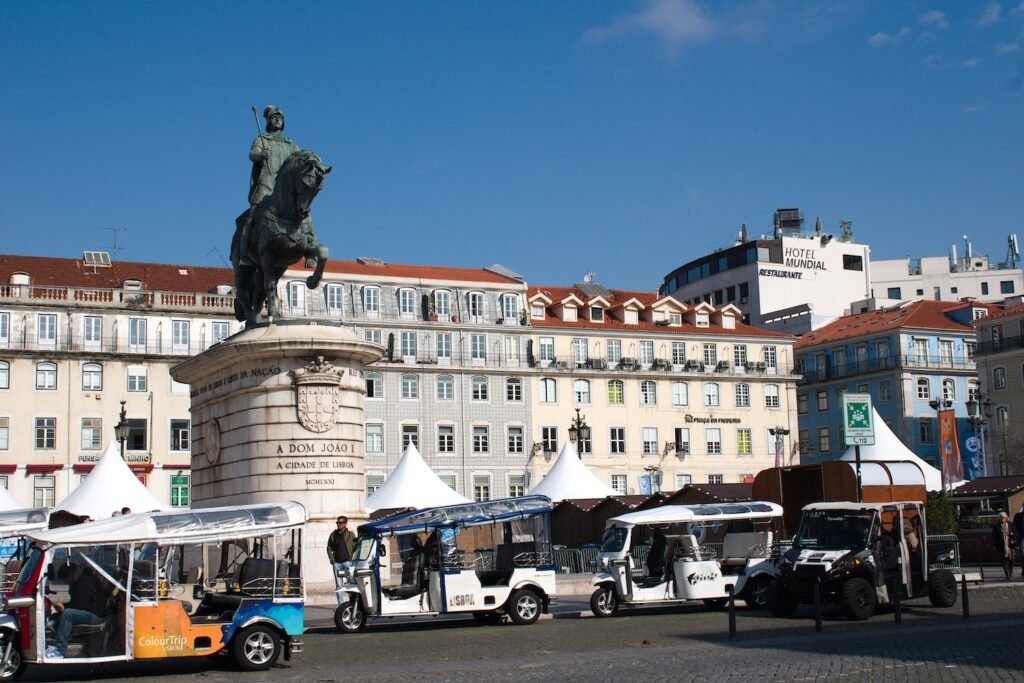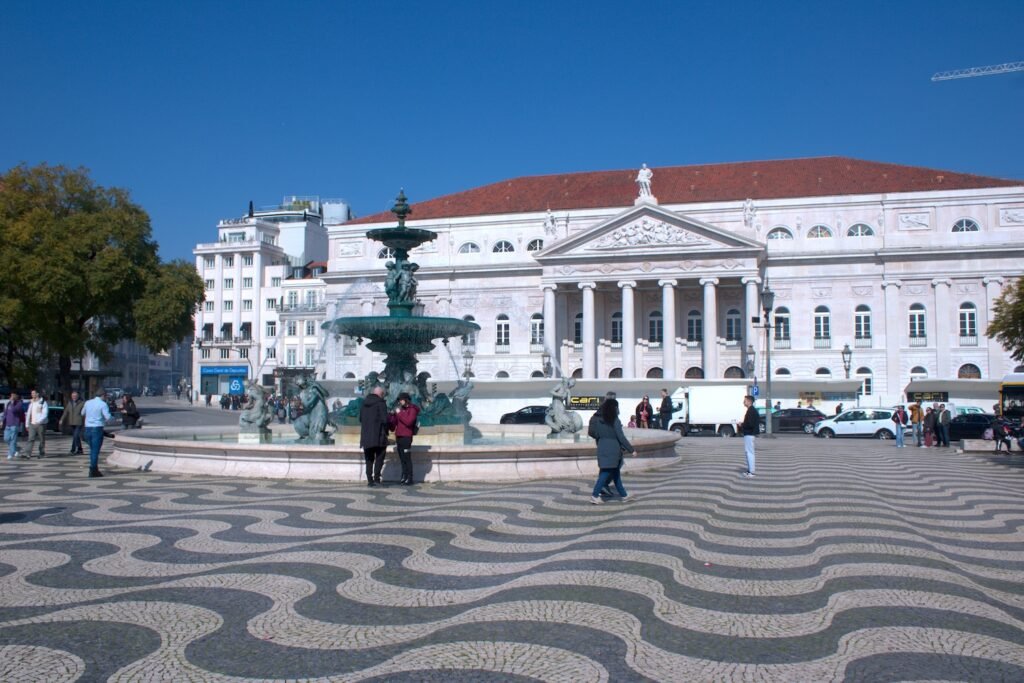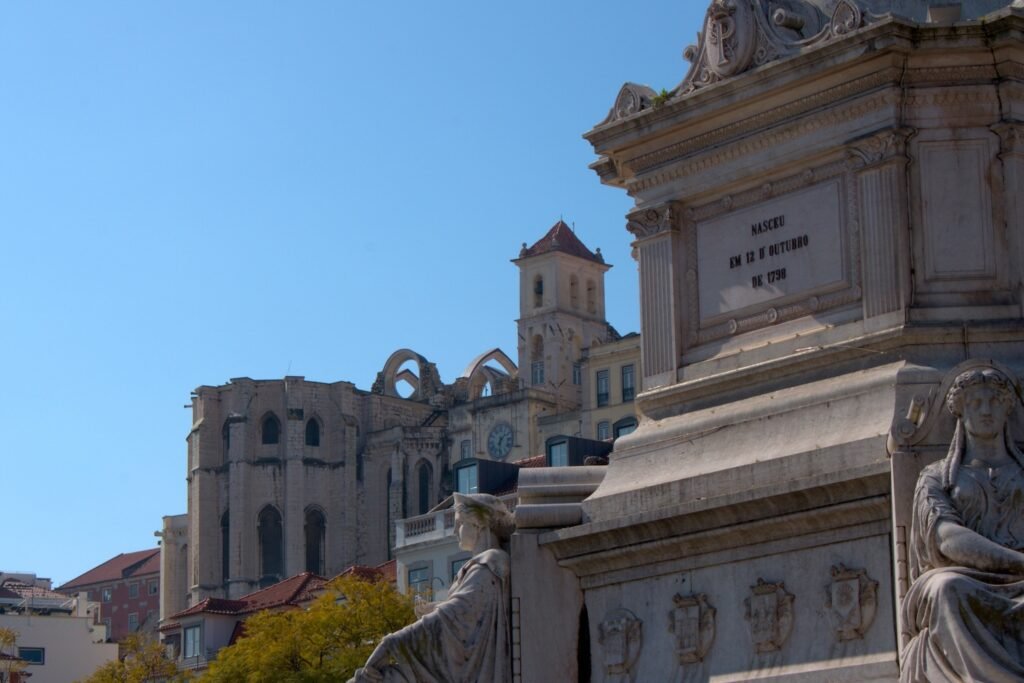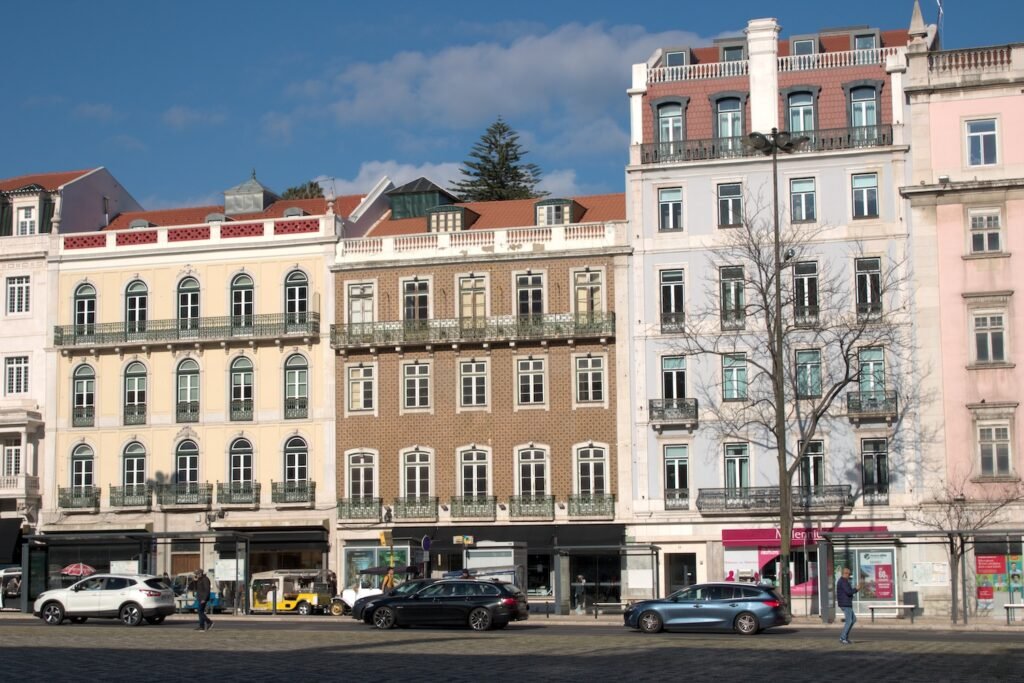Lisbon is a beautiful, historic city with tile lined buildings, numerous museums, and great views. You could easily spend two or three days exploring the city and not run out of things to do. But in this article, we’re going to assume that you only have one day in Lisbon. This guide will give you a one day itinerary that will provide a great introduction to this city.
One Day in Lisbon
This is not the only way that you can spend one day in Lisbon, but it’s how I would spend my time. Rather than focusing on visiting as many museums as possible, I recommend exploring the neighborhoods. In this one day itinerary, we’ll spend time in the Baxia, Barrio Alto, and Alfama neighborhoods. We’ll see some sights, stroll the streets, eat some great food, and have a little bit of time towards the end of the day to customize the itinerary to your preferences.
This itinerary starts at 9:00 am which will give you plenty of time to get a good breakfast before starting your day. If you want to cram in even more on your one day in Lisbon, such as more stops at museums, I’d recommend starting your day even earlier.

9:00 – Baxia Neighborhood
We’ll start our journey by exploring the Baxia neighborhood. Lisbon is hilly, but the Baxia neighborhood sits in a valley created by the hills of the Barrio Alto and the Alfama neighborhoods, both of which we’ll explore later.
I recommend starting in Praça do Comércio. This square is a hub of activity later in the day, but earlier in the morning, it will likely be a bit quieter. Still, based on what we plan to accomplish today, I think this makes a great starting point. Praça do Comércio sits right on the water and if you cross the street, you’ll see the Cais das Colunas which helped to form a historic port for Lisbon.
As you work your way away from the water, you’ll walk through the massive square which includes the statue of King José 1 in the center. Lining the square are restaurants, shops, and vendors. If the square doesn’t feel very lively when you’re here in the morning (especially if you start your day very early), consider returning later in the day to see the difference.
Continue working your way inland and under the Rua Augusta Arch, which leads you straight onto Rua Augusta. This pedestrian only shopping street is lined with restaurants and cafes and even a few shops. It’s gets busier as the day goes on, like all things in Lisbon, but continue strolling. Our long term goal is to make it to Rossio Square but at this point during the day, we aren’t in a big rush. Take your time and wander the side streets.
As you wander, there’s a few things you should lookout for. Look for Igreja de São Nicolau de Lisboa, or the Church of St. Nicholas, on Rua da Vitória. The Elevador de Santa Justa can provide a great view of the city, but we’ll get several, free views throughout the day so I’d recommend skipping this. Depending on the time of day Praça da Figueira can be a lively square with people grabbing a bite to eat or doing some shopping.
Rossio Square is even larger and more lively and sits right near the Rossio Station. Take a look near the station entrance for the statue. This had to be replaced because the original statue was broken when a tourist climbed it to take a selfie (yes, that is a true story). The National Theater also sits on one end of Rossio Square. Also near Rossio Square is the Igreja de São Domingos de Lisboa, or the Church of St. Dominic, and is worth a quick stop.
Continue walking toward the Momentos aos Restauradores, just off this square, you’ll find the Elevador de Gloria which will transition us into the next neighborhood.

10:30 – Barrio Alto Neighborhood
As we venture into the Barrio Alto neighborhood, you have a choice to make. We’ll be climbing up the hill along the Elevador de Gloria. You can either take the funicular (which costs 1.60 euro), or you can walk up. Yes the hill is a bit steep, but I think it’s perfectly reasonable to climb up the hill versus paying to ride the short funicular.
Like in the Baxia neighborhood, you’ll wander your way through the streets, taking in the sights as you pass them. I don’t have a set route, but like in the Baxia neighborhood, I have a few sights that you should watch out for.
Stop in a park for Mirador de São Pedro de Alcântara. This terrace offers a great view of the city of Lisbon. Specifically you’ll be overlooking the Baxia neighborhood that you just explored and over to the castle at the Alfama neighborhood. This a great view and one of my favorites of the day, but don’t worry, there are plenty more. Igreja de São Roque is one of Portugal’s first Jesuit churches and it’s worth a quick stop. Largo do Carmo is a square with a picturesque fountain and it’s right nearby Convento do Carmo.
When you were in the Baxia neighborhood, if you looked up toward Barrio Alto, you likely saw what looked to be the ruins of a castle or church. That’s Convento do Carmo. The convent was destroyed during the earthquake of 1755, but the walls remained. To this day, the walls have remained untouched as a reminder of what happened. For a fee, you can enter the Convent to visit the memorial park.
The Elevador de Santa Justa can more easily be accessed here, but again, I think there are so many free views of Lisbon that I’d save your money (we’ll have several in the Alfama neighborhood too). Café a Brasileria will likely have a line but it’s a famous place for coffee and custard treats (though there are numerous other places throughout the city that will sell pastel de natas). Rua Garrett is a street that features more of the mosaic tiles on the sidewalk and is a great place to shop, though notice how many tourists just stick to this street and don’t venture one or two blocks over.

12:00 – En Route to Lunch
It’s time to start making our way to lunch. While there are loads of places that you could stop at for lunch within the Barrio Alto area, we’re going to head elsewhere. Our destination is about a 15 minute walk from Rua Garrett, but we’re going to incorporate two stops along the way. The first is for the Bica Funicular which runs along Rua da Bica de Duerte Belo. This is a great photo stop if you’re patient enough to wait for the funiculars. But be warned that plenty of other people are trying to get that perfect shot as well.
The other stop that I want to mention is Pink Street. Personally, I think it’s overrated, but you’re right nearby so stop (it’ll just take a minute) and decide for yourself. Pink Street is famous for its rainbow umbrellas that hang about the street. Personally, I think photos make it look cooler than it is. The umbrellas are only there for a short distance and it just makes you realize how good people are at cropping their photos to make things look cooler than it actually is. But, you’ll walk within a block or two of it as you make your way to lunch, so it’s a quick stop.
12:30 – Lunch
For lunch, I’m recommending the Time Out Market. This is a covered market that is lined with restaurants serving all kinds of food. If you’re traveling in a group, this can be a great choice because everyone can get what they want. Step up to whichever restaurant looks good (or sample from several), order your food, take your tray, and find an open spot along the long tables. You’ll inevitably sit by strangers as it’s just long wooden tables that encourage people to meet each other.
While all of the times in this itinerary are approximations, I do have to give a note about visiting Time Out Market. While it’s fun and the food is good and plentiful, it can be very busy at lunch time. I arrived at 1:30 on a Sunday and the place was packed, so I left, explored a few places nearby (like the Bica Funicular and Pink Street) and came back an hour later. It was still busy but so much more manageable. As I designed this itinerary, my hope is that you’ll get there before it gets insanely busy.

2:00 – Alfama Neighborhood
After lunch, it’s time to head to our last neighborhood of the day: the Alfama Neighborhood. So far we’ve spent time in Baxia (the valley between two hills) and Barrio Alto (the western hill), so now it’s time to visit the eastern hill. Like with the Barrio Alto neighborhood, you have a choice for how to get to the neighborhood and start your stroll. I recommend starting near the Castelo do São Jorge, but it’s a bit of a hike to get there. Public transportation does run to the castle, but if you’re up for a little uphill walk, there’s a free way to do this.
First, go to Rua dos Fanquieros #178. This is super easy to miss (I walked right past) because it’s not really anything notable. Use your phone to navigate to it and enter the doorway. Straight back against the wall is an elevator that is free for the public to use. Take the elevator to the very top floor. Once you exit the elevator, you’ll be right near a little square.
Follow along the square to the left along Largo Chão do Loureiro. This will take you to a supermarket where you’ll find another public elevator. Ride this one up to the top as well. This elevator takes you to a cafe with a nice view of Lisbon. After you snap your quick photo, look for brown signs that direct you to the castle. You’ll still have a short walk uphill, but by using those two free elevators, it’s significantly more manageable.
While I recommend starting near the castle, it’s up to you if you want to pay the fee to go in to explore the castle. The big draw for entering the castle is the views of the city, but much of the castle is just rebuilt ruins. I skipped the castle entrance fee because I was satisfied with the views I got in the Barrio Alto neighborhood and the views that will come later in this Alfama neighborhood stroll, but I can completely understand if you want to explore the castle.
Beyond the castle, there’s a few stops I recommend making as you work your way through this neighborhood. While much of Lisbon was rebuilt after the 1755 earthquake in a grid like city plan, the Alfama neighborhood still maintains the windy lanes that many European cities are famous for. For viewpoints, I like both Miradouro de Santa Luzia and Miradouro das Portos do Sol. While you’re here, don’t miss the tile panels illustrating Lisbon before the earthquake. Largo de São Miguel is a small square but it provides a great starting place to explore more of this neighborhood.
As you wrap up in the Alfama Neighborhood and start making your way back to Praça do Comércio (it’ll likely be more lively now that it was in the morning), don’t forget a stop at the Lisbon Cathedral. This is not my favorite cathedral in Europe, but a stop here can be quick. It also provides a nice photo opportunity if you get lucky with your timing. The line 28 tram circles right in front of the cathedral which can make a nice photo. The only problem this area is so busy with taxis, tuk-tuks, and tourists that it can be hard to get as nice of a photo as you might be envisioning.

4:00 – Traveler’s Choice
The evening is yours to explore. That said, there are numerous museums that I did not cover on this itinerary. With just one day, you’ll need to prioritize what is important to you. Here’s a few things you should look at. Then, while you’re in the area, tack those on.
Fado Museum – If you have an interest in this traditional Portuguese music, this may be the museum for you. Look for this in the Alfama neighborhood.
Museum and School of Portuguese Decorative Arts – This museum lets you stroll through an aristocratic home to see the fine art and decor. Look for this in the Alframa neighborhood.
National Tile Museum – If you don’t mind taking the bus out a bit further, the National Tile Museum tells the story of tiles in Lisbon with so many historical tiles and a beautiful church. This is a bit east of the Alfama neighborhood and if you choose this, I’d highly suggest the bus and being efficient in your strolling through the neighborhoods.
National Pantheon – This is also just east of the Alfama neighborhood, but if you don’t mind a bit of a walk, I think it’s reasonable to walk here. This mausoleum is beautiful and holds the tombs of important citizens of Portugal.
This is not an exhaustive list, but with one day in Lisbon, there’s only so much you can see. Still, if you find something else that interests you even more, feel free to include it in your one day itinerary. Just make sure to pace the rest of your day appropriately.

Is One Day in Lisbon Enough?
It depends on the traveler. One day will give you enough time to stroll the neighborhoods, but there’s so much more to see in Lisbon. You won’t have a lot of time to visit some of the museums, venture to Belém, or even look into some of Lisbon’s day trips (like Sintra). If you’re short on time, you can make one day in Lisbon work, but I think it can be a bit more enjoyable if you have just a bit more time.
Learn more with my two day Lisbon itinerary.
With More Time
You will have plenty of options if you have more than one day in Lisbon. With two days, I’d recommend exploring more of the museums and venturing out to Belém for the famous Jerónimos Monastery and to eat a fresh, warm pastaís de Belém.
The other option is to look into a day trip from Lisbon. The most popular is a day trip to Sintra which is home to numerous exciting palaces to explore, including the striking Pena Palace.
I spent three days in Lisbon. My first day was an overview of the city that loosely followed this itinerary. On my second day I traveled to Belém before retuning to the historic center and visiting some of the sights and museums I had missed the previous day. On the third day, I took a day trip to Sintra and toured four of their palaces.

Getting Around Lisbon
In general, Lisbon is a very walkable city, though you’ll need to be prepared for hills. I walked a lot throughout Lisbon, but there will be times where you’ll need to rely on public transportation. If you’re traveling to the airport, Belém, or certain museums, you won’t have much of a choice.
Luckily, Lisbon’s public transportation makes it easy to get around. The easiest way is to pick up a reloadable Navegante card. These can be purchased from machines at any of the metro stations (including the airport). The card itself costs 50 cents, but then you can load up the card as needed.
There are two ways to load up the card. The first is to purchase journeys. The second is to just load the card with cash and “zap” your way around the city. The card will automatically deduct the appropriate amount (usually about 1.60 euros per journey) when you tap to enter a bus, tram, or metro stop. The Navegante card can also be used to take the train to Sintra.
Do some research before you travel and figure out how much you plan to use public transportation. While the Navegante cards are easy to reload, they are not refundable. Once the money is loaded onto the card, it’s not possible to get it off, so be conservative with your estimate. You can always add more money to your card, but you don’t want to finish your trip with loads of unspent euros on it.
Tips for Managing Crowds
Lisbon is very busy. I like to travel in the shoulder season and the off season as a way to try to minimize crowds. While I do believe that crowds were smaller than they would have been if I would have traveled during peak season, there were still a lot of tourists in Lisbon. So, let’s talk briefly about how to deal with crowds.
First, when possible, I recommend purchasing a ticket for whichever sight you are visiting ahead of time. There are a few sights where I don’t think this is necessary (The National Tile Museum comes to mind), but for many other sights, you will save time waiting in line. As a note, not every sight allows you skip the line entrance. Some sights will require you to enter at a certain time and others (such as the Jerónimos Monastery in Belém) will not allow you to skip the line. Make sure you understand the terms of your prepurchased ticket. For sights like Jerónimos Monastery, I recommend trying to arrive as early as possible to try to beat the crowds.
Along with crowds at paid sights, you’ll also experience crowds on the streets and public transportation—particularly the stops and line that serve many tourist destinations. On a busy day, you may have to wait for the second or third bus or tram to get where you’re going. While it’s easy to say “just get there early”, there are plenty of places where it’s not enough to just get there early. Give yourself plenty of time to get to where you need to go.

When to Visit Lisbon
Lisbon can be visited all year round. Peak tourist season is during the summer months. Low season is during the winter months, but don’t expect to have the sights to yourself. This may work in other destinations, but in Lisbon, you should expect crowds all year round (though they are more pronounced during the summer months).
In terms of weather, summers can get very hot. Winters are cooler and can have rain. If the weather is the biggest concern, I’d recommend looking to travel in late spring or fall. This should help reduce tourist crowds as well.
Where to Stay in Lisbon
I recommend staying near the city center and historic downtown area of the city. Many of the sights that you’ll want to see are clustered around this area and it’s where most of this one day itinerary is focused. Now, you don’t have to stay exactly in the city center. I stayed just outside the historic downtown (right between the Anjos and Intendente metro stops). I had a 15 to 20 minute walk to get to the Baxia neighborhood. Yes the walk added a bit more to my day, but staying just outside the historic downtown helped to save a few euros that could be used on other things.
Final Thoughts
Lisbon is a beautiful city and it is just not possible to see everything with one day in the city. However, I think this one day itinerary provides a great introduction to the city and will no doubt leave you wanting to see more.
Continue Your Adventure
Portugal: If you have more time, check out my two day Lisbon itinerary. Lisbon is great, but don’t miss some of its great day trips like Sintra for its amazing palaces. Check out my budget breakdown to get an idea of what your trip to Lisbon will cost and don’t miss my top travel tips.
Spain: Portugal shares the Iberian Peninsula with Spain. Take in the architecture of Barcelona, the Alhambra of Granada, the relaxed vibe of Sevilla, or one of the great day trips from Madrid.
